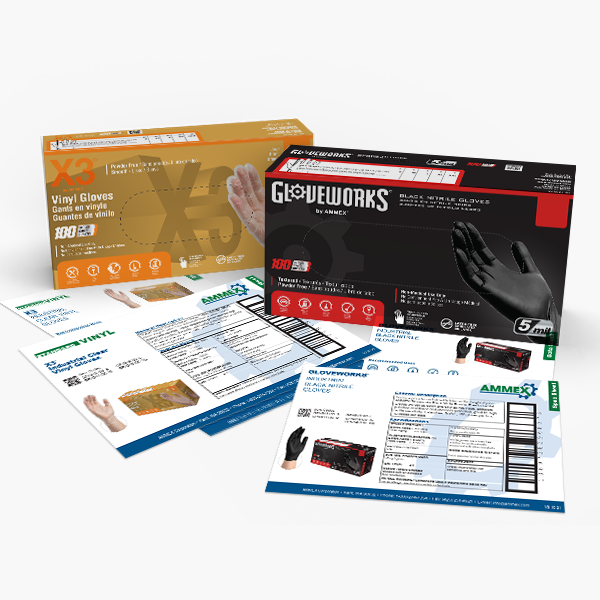How do you find the right glove for the job?
We hear all the time that customers have trouble choosing—and sometimes it takes a few tries to get it right. Here are the top 6 disposable glove specs that should figure into any eventual choice.
As is the case with any product or service, an informed customer is a happy customer, so start with the basics:
Thickness starts any glove conversation
- Glove thickness is measured in mils, equal to one-thousandth of an inch. A 3-mil glove is right for lightweight tasks like working with food, while an 8-mil glove is for heavier-duty jobs like automotive. There are specialty gloves up to 50 mils and more that are used for hazardous chemicals.
- Color is a consideration primarily for nitrile gloves. Vinyl gloves are mostly clear or blue—though there has been black hybrid vinyl on the market in the last couple of years—and latex are ivory, blue, or white. Nitrile, however, comes in a veritable rainbow of colors. AMMEX sells nitrile gloves in high-visibility orange and green, blue, black, indigo, and royal blue. Healthcare users often use color-coding of exam-grade gloves to differentiate between processes and specialties and guard against cross-contamination.
- Weight has been called a more accurate statistic than mil thickness for the amount of material used in a glove. Because gloves are manufactured by dipping hand-shaped formers, fingers pointed down, into a liquid mixture, gravity ensures that wrist thickness will be lower than that of the fingers. Measuring gloves with a digital scale, therefore, is a more precise measurement than using a micrometer to gauge thickness.

- Texture ranges from smooth (for vinyl gloves) to aggressive (Raised Diamond Texture for nitrile heavy-duty gloves). The latter utilizes 60% more surface area to channel away liquids for enhanced grip and is preferred for working with tools and machinery.
- Length is fairly standard across the industry: 9½ inches from tip of finger to base of wrist. There are exceptions, most common being 12-inch gloves used in laboratory and EMT applications to prevent liquids from splashing back. Some chemical-resistant and other specialty gloves are shoulder length.
- Acceptable Quality Limit (AQL) is an industry standard established by the American National Standards Institute, or ANSI. It is applied to a production order to define whether the entire order is under or over the maximum acceptable number of defects for a particular sample size. In a batch of 100 gloves with an AQL of 3.0, only three gloves in that batch can fail a pinhole test that checks for leaks. A lower number means a higher-rated glove; an AQL of 1.0 means the glove is exam or medical grade and suited for protection against bloodborne pathogens.
Exam grade vs. industrial grade
When helping your customers find the right glove, try a few variations to narrow down the choices. Exam-grade gloves cost significantly more than industrial grade, but the quality is not always significantly better. Unless your customer has a specific medical need, industrial is the right fit for most applications.
Call your sales rep or log into your account at our Online Portal to see what’s available.






